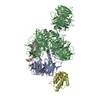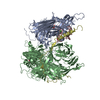+ Open data
Open data
- Basic information
Basic information
| Entry | Database: PDB / ID: 8qh5 | |||||||||
|---|---|---|---|---|---|---|---|---|---|---|
| Title | CryoEM structure of UVSSA(VHS)-CSA-DDB1-DDA1 | |||||||||
 Components Components |
| |||||||||
 Keywords Keywords | LIGASE / Ubiquitin ligase / DNA repair | |||||||||
| Function / homology |  Function and homology information Function and homology informationRNA polymerase inhibitor activity / regulation of transcription-coupled nucleotide-excision repair / nucleotide-excision repair complex / response to auditory stimulus / single strand break repair / positive regulation by virus of viral protein levels in host cell / double-strand break repair via classical nonhomologous end joining / chromatin-protein adaptor activity / spindle assembly involved in female meiosis / epigenetic programming in the zygotic pronuclei ...RNA polymerase inhibitor activity / regulation of transcription-coupled nucleotide-excision repair / nucleotide-excision repair complex / response to auditory stimulus / single strand break repair / positive regulation by virus of viral protein levels in host cell / double-strand break repair via classical nonhomologous end joining / chromatin-protein adaptor activity / spindle assembly involved in female meiosis / epigenetic programming in the zygotic pronuclei / UV-damage excision repair / biological process involved in interaction with symbiont / regulation of mitotic cell cycle phase transition / WD40-repeat domain binding / Cul4A-RING E3 ubiquitin ligase complex / Cul4-RING E3 ubiquitin ligase complex / Cul4B-RING E3 ubiquitin ligase complex / ubiquitin ligase complex scaffold activity / negative regulation of reproductive process / negative regulation of developmental process / RNA polymerase II complex binding / cullin family protein binding / viral release from host cell / site of DNA damage / response to X-ray / ectopic germ cell programmed cell death / positive regulation of viral genome replication / ubiquitin-like ligase-substrate adaptor activity / response to UV / proteasomal protein catabolic process / protein autoubiquitination / transcription-coupled nucleotide-excision repair / positive regulation of gluconeogenesis / positive regulation of DNA repair / nucleotide-excision repair / Recognition of DNA damage by PCNA-containing replication complex / regulation of circadian rhythm / DNA Damage Recognition in GG-NER / Dual Incision in GG-NER / Transcription-Coupled Nucleotide Excision Repair (TC-NER) / Formation of TC-NER Pre-Incision Complex / Formation of Incision Complex in GG-NER / Wnt signaling pathway / nuclear matrix / protein polyubiquitination / Dual incision in TC-NER / Gap-filling DNA repair synthesis and ligation in TC-NER / positive regulation of protein catabolic process / cellular response to UV / rhythmic process / positive regulation of proteasomal ubiquitin-dependent protein catabolic process / site of double-strand break / chromosome / Neddylation / response to oxidative stress / ubiquitin-dependent protein catabolic process / protein-macromolecule adaptor activity / perikaryon / proteasome-mediated ubiquitin-dependent protein catabolic process / damaged DNA binding / chromosome, telomeric region / protein ubiquitination / DNA repair / apoptotic process / DNA damage response / negative regulation of apoptotic process / protein-containing complex binding / nucleolus / protein-containing complex / extracellular space / DNA binding / extracellular exosome / nucleoplasm / nucleus / cytoplasm Similarity search - Function | |||||||||
| Biological species |  Homo sapiens (human) Homo sapiens (human) | |||||||||
| Method | ELECTRON MICROSCOPY / single particle reconstruction / cryo EM / Resolution: 3.4 Å | |||||||||
 Authors Authors | Lee, S.-H. / Sixma, T.K. | |||||||||
| Funding support |  Netherlands, European Union, 2items Netherlands, European Union, 2items
| |||||||||
 Citation Citation |  Journal: Nat Commun / Year: 2024 Journal: Nat Commun / Year: 2024Title: The small CRL4 ubiquitin ligase component DDA1 regulates transcription-coupled repair dynamics. Authors: Diana A Llerena Schiffmacher / Shun-Hsiao Lee / Katarzyna W Kliza / Arjan F Theil / Masaki Akita / Angela Helfricht / Karel Bezstarosti / Camila Gonzalo-Hansen / Haico van Attikum / Matty ...Authors: Diana A Llerena Schiffmacher / Shun-Hsiao Lee / Katarzyna W Kliza / Arjan F Theil / Masaki Akita / Angela Helfricht / Karel Bezstarosti / Camila Gonzalo-Hansen / Haico van Attikum / Matty Verlaan-de Vries / Alfred C O Vertegaal / Jan H J Hoeijmakers / Jurgen A Marteijn / Hannes Lans / Jeroen A A Demmers / Michiel Vermeulen / Titia K Sixma / Tomoo Ogi / Wim Vermeulen / Alex Pines /     Abstract: Transcription-blocking DNA lesions are specifically targeted by transcription-coupled nucleotide excision repair (TC-NER), which removes a broad spectrum of DNA lesions to preserve transcriptional ...Transcription-blocking DNA lesions are specifically targeted by transcription-coupled nucleotide excision repair (TC-NER), which removes a broad spectrum of DNA lesions to preserve transcriptional output and thereby cellular homeostasis to counteract aging. TC-NER is initiated by the stalling of RNA polymerase II at DNA lesions, which triggers the assembly of the TC-NER-specific proteins CSA, CSB and UVSSA. CSA, a WD40-repeat containing protein, is the substrate receptor subunit of a cullin-RING ubiquitin ligase complex composed of DDB1, CUL4A/B and RBX1 (CRL4). Although ubiquitination of several TC-NER proteins by CRL4 has been reported, it is still unknown how this complex is regulated. To unravel the dynamic molecular interactions and the regulation of this complex, we apply a single-step protein-complex isolation coupled to mass spectrometry analysis and identified DDA1 as a CSA interacting protein. Cryo-EM analysis shows that DDA1 is an integral component of the CRL4 complex. Functional analysis reveals that DDA1 coordinates ubiquitination dynamics during TC-NER and is required for efficient turnover and progression of this process. #1:  Journal: To Be Published Journal: To Be PublishedTitle: CryoEM structure of UVSSA(VHS)-CSA-DDB1-DDA1 Authors: Lee, S.-H. / Sixma, T.K. | |||||||||
| History |
|
- Structure visualization
Structure visualization
| Structure viewer | Molecule:  Molmil Molmil Jmol/JSmol Jmol/JSmol |
|---|
- Downloads & links
Downloads & links
- Download
Download
| PDBx/mmCIF format |  8qh5.cif.gz 8qh5.cif.gz | 514.3 KB | Display |  PDBx/mmCIF format PDBx/mmCIF format |
|---|---|---|---|---|
| PDB format |  pdb8qh5.ent.gz pdb8qh5.ent.gz | 407.9 KB | Display |  PDB format PDB format |
| PDBx/mmJSON format |  8qh5.json.gz 8qh5.json.gz | Tree view |  PDBx/mmJSON format PDBx/mmJSON format | |
| Others |  Other downloads Other downloads |
-Validation report
| Summary document |  8qh5_validation.pdf.gz 8qh5_validation.pdf.gz | 717.6 KB | Display |  wwPDB validaton report wwPDB validaton report |
|---|---|---|---|---|
| Full document |  8qh5_full_validation.pdf.gz 8qh5_full_validation.pdf.gz | 740.4 KB | Display | |
| Data in XML |  8qh5_validation.xml.gz 8qh5_validation.xml.gz | 49.8 KB | Display | |
| Data in CIF |  8qh5_validation.cif.gz 8qh5_validation.cif.gz | 76.6 KB | Display | |
| Arichive directory |  https://data.pdbj.org/pub/pdb/validation_reports/qh/8qh5 https://data.pdbj.org/pub/pdb/validation_reports/qh/8qh5 ftp://data.pdbj.org/pub/pdb/validation_reports/qh/8qh5 ftp://data.pdbj.org/pub/pdb/validation_reports/qh/8qh5 | HTTPS FTP |
-Related structure data
| Related structure data |  18398MC C: citing same article ( M: map data used to model this data |
|---|---|
| Similar structure data | Similarity search - Function & homology  F&H Search F&H Search |
- Links
Links
- Assembly
Assembly
| Deposited unit | 
|
|---|---|
| 1 |
|
- Components
Components
| #1: Protein | Mass: 82923.164 Da / Num. of mol.: 1 Source method: isolated from a genetically manipulated source Details: The construct contains an N-terminal His tag. / Source: (gene. exp.)  Homo sapiens (human) / Gene: UVSSA, KIAA1530 / Production host: Homo sapiens (human) / Gene: UVSSA, KIAA1530 / Production host:  |
|---|---|
| #2: Protein | Mass: 45465.613 Da / Num. of mol.: 1 Source method: isolated from a genetically manipulated source Details: The construct contains a Strep tag II at the C-terminus Source: (gene. exp.)  Homo sapiens (human) / Gene: ERCC8, CKN1, CSA / Production host: Homo sapiens (human) / Gene: ERCC8, CKN1, CSA / Production host:  |
| #3: Protein | Mass: 129298.867 Da / Num. of mol.: 1 Source method: isolated from a genetically manipulated source Details: The construct contains an N-terminal His tag. / Source: (gene. exp.)  Homo sapiens (human) / Gene: DDB1, XAP1 / Production host: Homo sapiens (human) / Gene: DDB1, XAP1 / Production host:  |
| #4: Protein | Mass: 16997.615 Da / Num. of mol.: 1 Source method: isolated from a genetically manipulated source Details: The construct contains a TwinStrep tag and a Flag tag at the C-terminus. Source: (gene. exp.)  Homo sapiens (human) / Gene: DDA1, C19orf58, PCIA1 / Production host: Homo sapiens (human) / Gene: DDA1, C19orf58, PCIA1 / Production host:  |
| Has protein modification | N |
-Experimental details
-Experiment
| Experiment | Method: ELECTRON MICROSCOPY |
|---|---|
| EM experiment | Aggregation state: PARTICLE / 3D reconstruction method: single particle reconstruction |
- Sample preparation
Sample preparation
| Component | Name: Ternary complex of UVSSA(VHS)-CSA-DDB1-DDA1 / Type: COMPLEX Details: Ternary complex of ubiquitinated UVSSA-USP7-CSA-DDB1-DDA1. USP7 is invisible in the cryoEM map. Entity ID: #2-#4, #1 / Source: RECOMBINANT | ||||||||||||||||||||
|---|---|---|---|---|---|---|---|---|---|---|---|---|---|---|---|---|---|---|---|---|---|
| Molecular weight | Value: 0.21 MDa / Experimental value: NO | ||||||||||||||||||||
| Source (natural) | Organism:  Homo sapiens (human) Homo sapiens (human) | ||||||||||||||||||||
| Source (recombinant) | Organism:  | ||||||||||||||||||||
| Buffer solution | pH: 7.5 | ||||||||||||||||||||
| Buffer component |
| ||||||||||||||||||||
| Specimen | Conc.: 0.13 mg/ml / Embedding applied: NO / Shadowing applied: NO / Staining applied: NO / Vitrification applied: YES / Details: This sample was glutaraldehyde crosslinked | ||||||||||||||||||||
| Specimen support | Details: The grid was coated with graphene oxide. / Grid material: COPPER / Grid mesh size: 300 divisions/in. / Grid type: Quantifoil R1.2/1.3 | ||||||||||||||||||||
| Vitrification | Instrument: FEI VITROBOT MARK IV / Cryogen name: ETHANE / Humidity: 100 % / Chamber temperature: 277 K |
- Electron microscopy imaging
Electron microscopy imaging
| Experimental equipment |  Model: Titan Krios / Image courtesy: FEI Company |
|---|---|
| Microscopy | Model: FEI TITAN KRIOS Details: Collected on Krios 1 at Netherlands Center for Electron Nanoscopy (NeCEN) |
| Electron gun | Electron source:  FIELD EMISSION GUN / Accelerating voltage: 300 kV / Illumination mode: FLOOD BEAM FIELD EMISSION GUN / Accelerating voltage: 300 kV / Illumination mode: FLOOD BEAM |
| Electron lens | Mode: BRIGHT FIELD / Nominal magnification: 81000 X / Nominal defocus max: 3000 nm / Nominal defocus min: 1000 nm / Cs: 2.7 mm / C2 aperture diameter: 100 µm / Alignment procedure: COMA FREE |
| Specimen holder | Cryogen: NITROGEN / Specimen holder model: FEI TITAN KRIOS AUTOGRID HOLDER |
| Image recording | Electron dose: 60 e/Å2 / Film or detector model: GATAN K3 BIOQUANTUM (6k x 4k) / Num. of grids imaged: 1 / Num. of real images: 1382 |
| EM imaging optics | Energyfilter slit width: 20 eV |
- Processing
Processing
| EM software |
| ||||||||||||||||||||||||||||||||||||||||||||||||||||||||||||||||||
|---|---|---|---|---|---|---|---|---|---|---|---|---|---|---|---|---|---|---|---|---|---|---|---|---|---|---|---|---|---|---|---|---|---|---|---|---|---|---|---|---|---|---|---|---|---|---|---|---|---|---|---|---|---|---|---|---|---|---|---|---|---|---|---|---|---|---|---|
| CTF correction | Type: PHASE FLIPPING AND AMPLITUDE CORRECTION | ||||||||||||||||||||||||||||||||||||||||||||||||||||||||||||||||||
| Particle selection | Num. of particles selected: 723908 | ||||||||||||||||||||||||||||||||||||||||||||||||||||||||||||||||||
| Symmetry | Point symmetry: C1 (asymmetric) | ||||||||||||||||||||||||||||||||||||||||||||||||||||||||||||||||||
| 3D reconstruction | Resolution: 3.4 Å / Resolution method: FSC 0.143 CUT-OFF / Num. of particles: 294142 Details: Combined from focused maps reconstructed with various particle numbers. Symmetry type: POINT | ||||||||||||||||||||||||||||||||||||||||||||||||||||||||||||||||||
| Atomic model building | Protocol: RIGID BODY FIT / Space: REAL Details: Additional densities are observed near several cysteine residues (A/Cys222, A/Cys260, A/Cys288, B/Cys363, B/Cys725, B/Cys1008). We expect these are oxidized products or crosslinking side products. | ||||||||||||||||||||||||||||||||||||||||||||||||||||||||||||||||||
| Atomic model building | 3D fitting-ID: 1
|
 Movie
Movie Controller
Controller







 PDBj
PDBj






